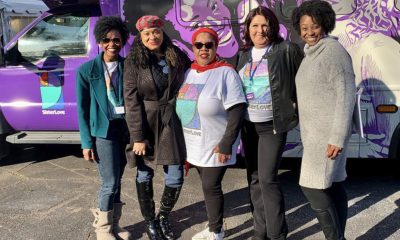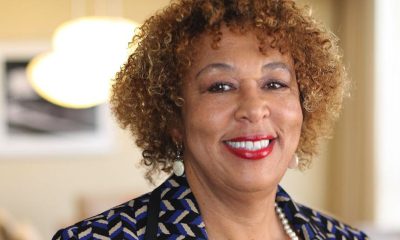Health
Concerns Remain for ‘Viagra for Women’ Twice Rejected by FDA

In this Friday, Sept. 27, 2013, file photo, a tablet of flibanserin sits on a brochure for Sprout Pharmaceuticals in the company’s Raleigh, N.C., headquarters. Sprout Pharmaceuticals, the makers of the twice-rejected pill intended to boost libido in women, will make a third attempt this week at convincing regulators to approve the drug as the first prescription treatment for low sexual desire in women. A panel of FDA experts will discuss the drug at a public meeting Thursday, June 4, 2015 before voting on whether to recommend its approval.(AP Photo/Allen G. Breed, File)
MATTHEW PERRONE, AP Health Writer
WASHINGTON (AP) — The makers of a pill intended to boost sexual desire in women will try again this week to persuade regulators that the drug warrants approval after two rejections.
But a new review released by the Food and Drug Administration shows government scientists still have concerns about whether the drug’s benefits outweigh its risks. The FDA review highlights several safety issues with flibanserin, including low blood pressure and fainting spells. Those problems increased when patients combined the drug with alcohol and some other medications, according to the document.
A panel of FDA experts will discuss the drug at a public meeting Thursday, before voting on whether to recommend its approval.
The ongoing saga of Sprout Pharmaceutical’s much-debated drug illustrates the complex politics and science surrounding women’s sexuality.
For decades, drugmakers have tried unsuccessfully to develop a female equivalent to Viagra, the blockbuster drug that treats men’s erectile dysfunction by increasing blood flow. But disorders of women’s sexual desire have proven resistant to drugs that act on blood flow, hormones and other simple biological functions.
Supporters of Sprout’s drug say women’s sexual disorders have been long overlooked by the FDA. But critics argue that drug development efforts like Sprout’s medicalize women’s sexual problems, which are often related to stress, relationship issues and other life circumstances.
“There are certainly women who have low libido and are distressed by it,” says Dr. Adriane Fugh-Berman, an associate professor at Georgetown University. “But for those women therapy is the best solution, because this is not a medical disease.”
Other critics say they would support a safe and effective drug for treating women’s libido problems, but none has yet emerged.
“If a company could show that a drug is effective based on clinically significant outcome measurements, then we’d be for it,” says Cindy Pearson, executive director of the National Women’s Health Network.
Flibanserin is the first drug to approach the issue through brain chemistry. Originally studied as an antidepressant, the pill was repurposed as a libido treatment after women in company studies reported higher levels of sexual satisfaction. But the FDA has twice rejected the drug because of lackluster effectiveness and side effects including fatigue, dizziness and nausea.
Clinicians who helped study flibanserin point out that they already prescribe other antidepressants without FDA approval to treat sexual desire disorders. They argue that those drugs, including Wellbutrin and Viibryd, carry worse side effects than flibanserin, such as agitation and seizures.
“We use them all the time for female sexual dysfunction,” says Dr. James Simon, a gynecologist who helped conduct several key studies of flibanserin. “The problem is that the side effect profile for doses that are effective for increasing desire and orgasm can be very high.”
Simon says the lack of an FDA-approved option for female sexual dysfunction means doctors must balance issues of safety and lack of insurance coverage while trying to help patients.
“We’re out there in the trenches every day trying to find a happy medium.”
It’s not entirely clear how flibanserin increases desire, but researchers point to its ability to boost dopamine — a brain chemical associated with appetite — while lowering serotonin, which is linked to feelings of satiation.
The FDA first rejected flibanserin in 2010 after a panel of expert advisers unanimously voted against the drug, saying its benefits did not outweigh its risks. Company studies showed women taking flibanserin reported roughly one more sexually satisfying experience per month than women taking placebo.
The drug’s initial developer, Boehringer Ingelheim, abandoned work on the drug in 2011 and sold it to Sprout, a startup company from Raleigh, North Carolina. Sprout resubmitted the drug with additional effectiveness and safety data, but the FDA again rejected the drug in October 2013. Sprout submitted the drug yet again earlier this year after filing a formal dispute over the FDA’s second rejection.
FDA’s review posted Tuesday underscores the ongoing rift between regulators and the company. The FDA acknowledges that flibanserin resulted in statistically significant increases in sexual events and desire, while decreasing distress. But the review concludes: “The fundamental question is whether these observed placebo-corrected treatment effects outweigh the risks associated with treatment.”
The FDA will ask its expert panel whether extra safety measures — including certification for doctors who wish to prescribe the drug — should be required if the drug is approved.
The FDA is not required to follow the advice of its panelists. The agency is expected to make a decision on whether to approve the drug in August..
Copyright 2015 The Associated Press. All rights reserved. This material may not be published, broadcast, rewritten or redistributed.
Bay Area
Mind, Body, and Spiritual Well-Being for Women Addressed in NAACP Forum in Oakland
The Women In The NAACP Oakland Branch is proud to announce the upcoming “Total You – Mind, Body, and Spirit Women’s Health Forum” scheduled for April 27 at Acts Full Gospel Church. Running from 9 a.m.-2 p.m. at 1034 66th Ave., this forum aims to provide an empowering platform for women to engage in discussions, gain knowledge, and access resources pertaining to their health and well-being.

Special to The Post
The Women In The NAACP Oakland Branch is proud to announce the upcoming “Total You – Mind, Body, and Spirit Women’s Health Forum” scheduled for April 27 at Acts Full Gospel Church.
Running from 9 a.m.-2 p.m. at 1034 66th Ave., this forum aims to provide an empowering platform for women to engage in discussions, gain knowledge, and access resources pertaining to their health and well-being.
The forum will feature renowned experts, healthcare professionals, and advocates from Genentech, John Muir Health, Sutter Health of The East Bay, Kaiser Permanente, and the Alameda County Public Health Department.
Our expert panel will address various aspects of women’s health, including physical, mental, and emotional well-being, and healthy relationships. The forum will encompass a wide range of topics such as breast cancer, menopause, reproductive health, nutrition, mental health awareness, preventive care, and much more.
Participants will have the opportunity to attend informative sessions, interactive workshops, and panel discussions led by experts in their respective fields. Additionally, there will be wellness activities, screenings, and informational booths offering valuable resources and support.
This forum is open to women of all ages and backgrounds, encouraging inclusivity and diversity in the conversation surrounding women’s health. Whether you’re seeking information for yourself, a loved one, or simply looking to connect with other women, this event promises to be enlightening and empowering.
For more information and to register for the Total You Women’s Health Forum, please visit https://www.naacpoakland.org/ or contact Dr. Delores Thompson. WIN chairwoman at (510) 328-3638.
The Women In The NAACP Oakland Branch is dedicated to empowering women, and young teen girls. We look forward to your participation in this important event.
To register, go to https://www.naacpoakland.org/events/the-total-you-womens-health-forum
Alameda County
Oakland Conducts Its Biennial ‘Point in Time’ Homelessness Count
Oakland, along with other cities in Alameda County, conducted their biennial ‘Point In Time’ census count on Feb. 1 to gain a thorough understanding of the size and dispersion of the homeless population in the region. The Point In Time (PIT) count is federally required by the Housing and Urban Development Department as a requirement to receive funding and resources to tackle homelessness in the area.

By Magaly Muñoz
Oakland, along with other cities in Alameda County, conducted their biennial ‘Point In Time’ census count on Feb. 1 to gain a thorough understanding of the size and dispersion of the homeless population in the region.
The Point In Time (PIT) count is federally required by the Housing and Urban Development Department as a requirement to receive funding and resources to tackle homelessness in the area.
David Modersbach, Grants Manager of Alameda County Health Care for the Homeless program, said that the methodology this time around was different, as this count had a much more personal “lived experience” aspect that previous counts did not have.
In 2022, the county relied more on statistical extrapolation and assumptions, but this year’s survey questionnaires allowed for details on substance abuse issues, how long someone has been living without proper housing, what resources people are in need of and much more.
“[The PIT count is] a critical opportunity for the county, Continuum of Care, and cities to understand the magnitude of homelessness in Alameda County. [The count] enables us to better allocate resources and implement effective programs to tackle this issue head-on in a compassionate and inclusive way,” Modersbach said.
St. Mary’s Center was one of the many meeting hubs across the county that hosted volunteers and community officials the morning of the count. The organization has been deeply involved in the effort to provide resources for unhoused people and others in need.
St. Mary’s is a nonprofit in West Oakland that helps seniors and preschool families with food and housing. Last year, the organization helped about 50 seniors find housing after they had fallen on hard times.
Sharon Cornu, executive director of St. Mary’s, said a lot of the older couples and individuals that come into the center have borne the brunt of the skyrocketing cost of living in the Bay Area. The most recent influx of seniors St. Mary’s has seen coming in for help has been made up of people who were evicted when the COVID-19-related moratorium on rent payment ended.
“Seniors are the fastest growing segment of the unhoused and the incredibly high cost of housing is driving them to the streets,” Cornu said.
Among the volunteers were workers with Operation Dignity, a nonprofit organization that helps veterans and those living on the street find shelter, transitional housing and supportive services.
“These are our stomping grounds,” Ivan Magana, program manager for Operation Dignity said.
Magana stated that his team was extremely familiar with the people residing in the encampments they were conducting the count in since Operation Dignity made many visits to these areas while doing community outreach. He said they had even informed some of the unhoused people they knew about the count a few days prior so they would not be alarmed when the enumerators showed up early in the morning to conduct the count.
Not everyone got the memo though, as the volunteers encountered an almost violent situation around the 6 a.m. when a young woman living in a bus yelled at the Operation Dignity workers to leave her alone.
Luckily, the three-year experience Mangana has working with Operation Dignity and his knowledge of therapeutic health services, equipped him with the techniques needed to deescalate the tension. The woman soon realized who the volunteers were and apologized, he said.
Another volunteer and Operation Dignity worker, Yolanda Kirkpatrick, noted that she was initially hesitant because of the early schedule. She felt the time deterred others from participating, too.
Her prediction would come true as the hours went on and they continued to walk along 24th St in downtown Oakland and there was very little activity on the streets.
The volunteers shared similar sentiments. Although the community the people they were engaging for the count and surveys encounter tend to distrust outsiders, the PIT count was necessary for the city to receive the appropriate level of federal funds to address a crisis that is spiraling out of control in California.
A full analysis and report of the count will be made available in the summer.
Community
For Cervical Cancer Month, Medical Community Focused on Education
January was Cervical Cancer Awareness Month. Physicians, advocates and others in the medical community commemorated the month by raising awareness about a form of cancer they say is highly preventable and treatable. Cervical cancer is caused by a virus called the human papillomavirus (HPV) and it develops slowly over time but can be prevented with proper care in girls as young as 13 years old.

By Magaly Muñoz
January was Cervical Cancer Awareness Month.
Physicians, advocates and others in the medical community commemorated the month by raising awareness about a form of cancer they say is highly preventable and treatable.
Cervical cancer is caused by a virus called the human papillomavirus (HPV) and it develops slowly over time but can be prevented with proper care in girls as young as 13 years old.
Sonia Ordonez, an OBGYN and gynecology surgeon at Kaiser Permanente, stated that as soon as people with cervixes reach the maturity reproductive age, they should start taking preventative measures like getting the HPV vaccine. The vaccine involves a series of two-doses for people aged 9 through 14 or three-doses for people 15 through 45 years old.
“I see a lot of young women who can’t remember or may not have gotten [the vaccine] when they were younger, or maybe got one, but we can give them the series of vaccines and restart at any point in time,” Ordonez said.
She said that cervical cancer is not the only cancer caused by HPV. Strains of the virus can also lead to throat, anal and penile cancers.
Screening is also an effective way to check for cervical cancer and should be done every three years after someone turns 21, doctors recommend. It is best to start as early as possible to catch occurrences early.
Ordonez said that this cancer is also more likely found in people of color and has led to more deaths overall.
A Mayo Clinic article published last month stated that Black women are more likely to be diagnosed and die of cervical cancer, compared to White women in the U.S.
2,000 Black women are diagnosed every year with cervical cancer and 40% die as a result.
“This disparity is not due to genetic differences among White, Black or Hispanic women, but rather related to systemic racism, access to healthcare and socioeconomic factors,” Dr. Olivia Cardenas-Trowers, a Mayo Clinic urogynecologist, said in the article.
Ordonez stated that immigrant women are also highly susceptible to the cancer, as many Latin American countries may not have accessibility to screenings or lack of insurance makes it harder for them to get tested.
Hispanic women are 40% more likely to be diagnosed with cervical cancer, and 30% more likely to die from it, as compared to non-Hispanic White women, according to the Office of Minority Health.
Family medicine physician, Joy Anyanwu, stated that the pandemic contributed to hesitancy about getting cervical cancer screenings among some women. Other factors are people’s aversion to vaccines, parents not wanting to believe that their children are or will become sexually active, and doubt about the overall effectiveness of the vaccine.
“The vaccine is very safe — over 97% effective in preventing cervical cancer,” Anyanwu said. “Even if you aren’t having sex, the earlier you start would actually help.”
Anyanwu said she understands that parents might not want to ask questions about their children’s reproductive health, but it’s a mindset that can be a barrier to having important conversation about prevention or care.
To keep families their families and communties healthy, the doctor emphasized that people should prioritize keeping up with their vaccine series and going to screenings every year.
-

 Activism4 weeks ago
Activism4 weeks agoOakland Post: Week of March 27 – April 2, 2024
-

 #NNPA BlackPress4 weeks ago
#NNPA BlackPress4 weeks agoBeloved Actor and Activist Louis Cameron Gossett Jr. Dies at 87
-

 Community1 week ago
Community1 week agoFinancial Assistance Bill for Descendants of Enslaved Persons to Help Them Purchase, Own, or Maintain a Home
-

 Activism3 weeks ago
Activism3 weeks agoOakland Post: Week of April 3 – 6, 2024
-

 Business1 week ago
Business1 week agoV.P. Kamala Harris: Americans With Criminal Records Will Soon Be Eligible for SBA Loans
-

 Activism2 weeks ago
Activism2 weeks agoOakland Post: Week of April 10 – 16, 2024
-

 Community1 week ago
Community1 week agoAG Bonta Says Oakland School Leaders Should Comply with State Laws to Avoid ‘Disparate Harm’ When Closing or Merging Schools
-

 Community6 days ago
Community6 days agoOakland WNBA Player to be Inducted Into Hall of Fame
























































